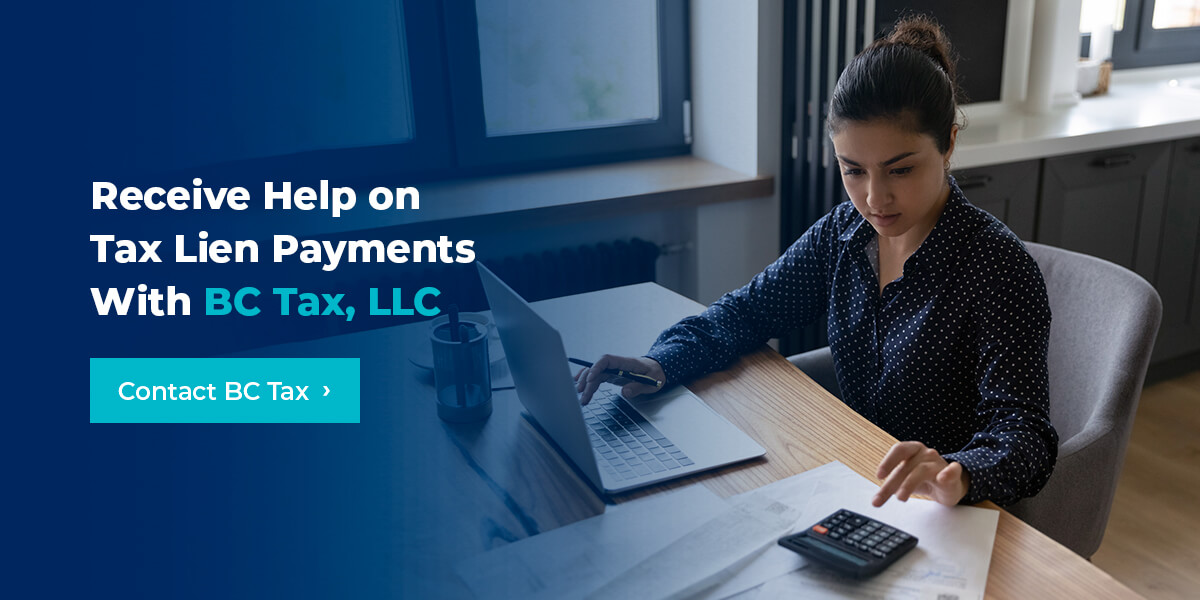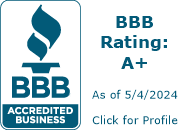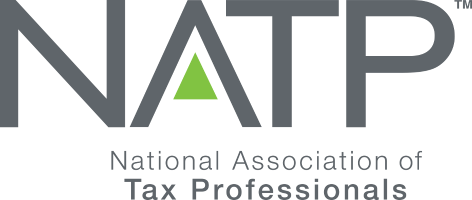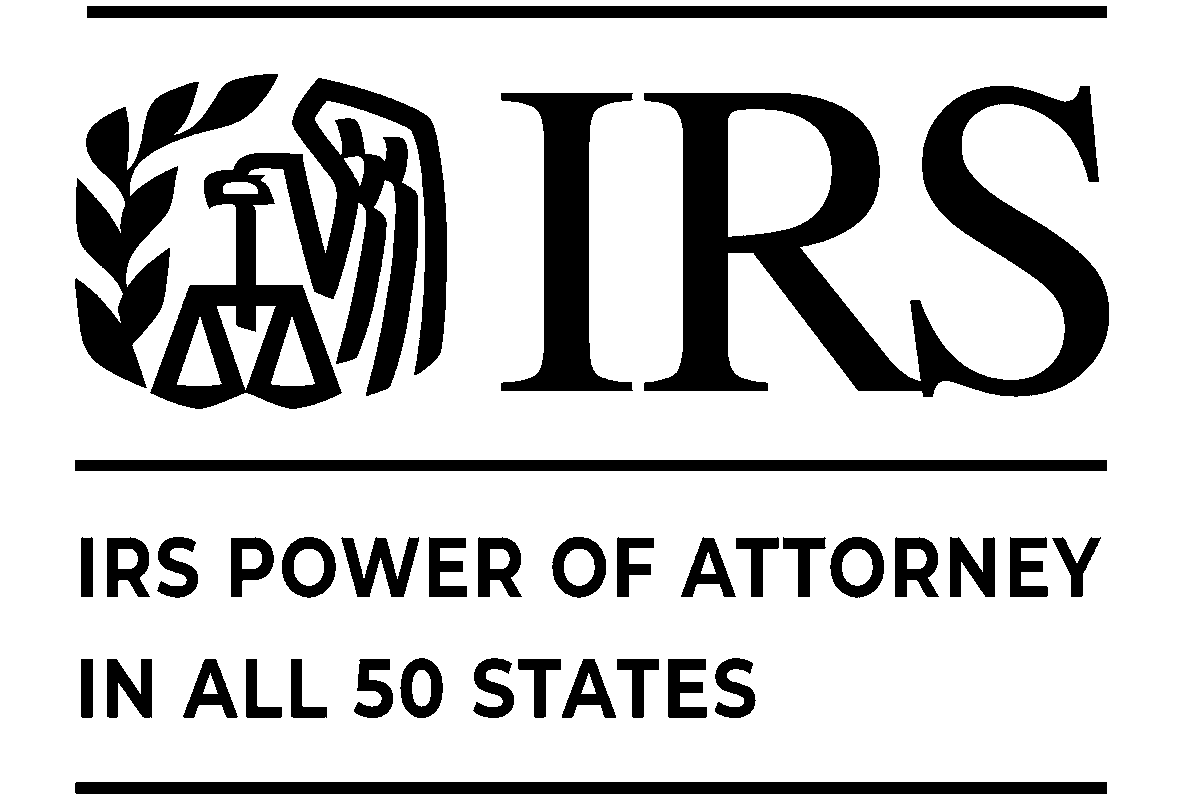Tax debt can pose unique challenges to taxpayers struggling to find ways to make payments. Tax liens can put more pressure and hardship on individuals by reducing their ability to secure loans or credit. When you’re struggling with a tax lien, understanding how to remove it can help reopen your financial opportunities.
What Is a Tax Lien?
A tax lien is a legal claim on a person’s properties and assets when they have outstanding tax debts. If the person doesn’t pay their debts, the tax issuer has first claim on those assets over other creditors. Depending on which taxes are unpaid, a lien can come from several taxing authorities, including the federal, state and local governments.
How Do You Know If You Have a Tax Lien?
When you have unpaid taxes, the Internal Revenue Service (IRS) will issue a Notice and Demand for Payment outlining what you owe. If you don’t pay the debt by the deadline they provide, they’ll then issue the lien.
The IRS will file a Notice of Federal Tax Lien, notifying other creditors that you have outstanding debt to the government that gives them the right to your property first. Your notice will provide essential information about your tax lien’s filing date. It will also contain information about your right to a due process hearing, where you can appeal the lien.
A tax lien will appear on your credit reports and might hurt your score, deterring creditors from issuing loans and mortgages.
How to Remove a Tax Lien
Receiving a lien can be scary and frustrating. When you want to know how to remove an IRS tax lien, you have several options depending on your circumstances and eligibility.
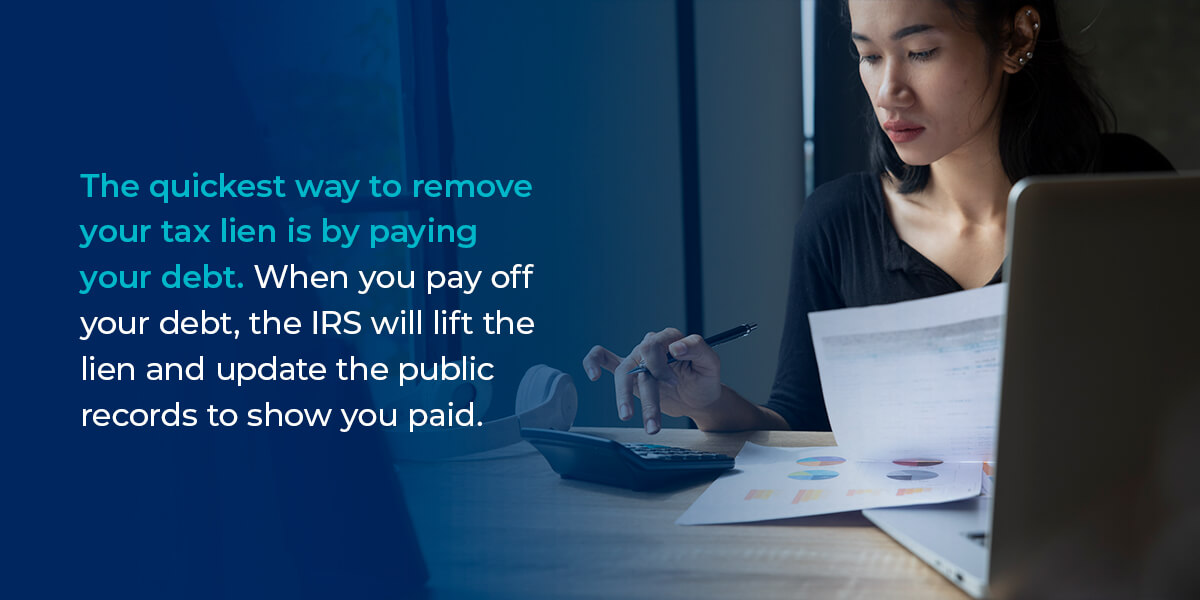
1. Pay the Tax Debt
The quickest way to remove your tax lien is by paying your debt. Once you pay the IRS what you owe, the agency will update public records and lift the tax lien within 30 days. With the lien lifted, you can streamline complicated processes like applying for credit, receiving loans and selling assets.
If paying the debt fully isn’t feasible, you have other options for removing a tax lien or limiting its impact on you. Whether you want to explore alternatives or need more information about how to pay off a tax lien, tax professionals like the BC Tax team can help you navigate the process.
2. Secure an Installment Agreement
Paying off your entire tax debt in one payment may be challenging. In these situations, you can set up a payment plan with the IRS, setting an amount and allowing them to make regular withdrawals from your bank account. They may require automatic payments to ensure you meet their payment schedule, which will simplify the process for you.
Ignoring lien notices can count as debt neglect — it’s essential to contact the IRS and respond to your lien notices immediately if you can’t pay your loan right away. Working with them allows you to determine a schedule that lets you pay your debt in digestible chunks.
3. Receive a Discharge of Property
Generally, a tax lien applies to all the property you own, from your home to your bank accounts and your car to your stocks. While a discharge of property will not entirely remove your tax lien, it can remove it from a specific piece of property. When you want to sell your property, having a discharge can make it easier to find interested buyers. Without one, the lien will still exist, giving the IRS priority over the new owners and discouraging people from buying. The IRS might be willing to release or discharge a particular asset from the lien in some cases. A discharge lets you sell the property without encumbrance and without the IRS getting to claim the value of the sale.
Not every taxpayer qualifies for a discharge. If you’re considering this option, the tax professionals at BC Tax can review your situation and help you decide if a tax lien discharge is appropriate for you and if your property is eligible for discharge.
The Internal Revenue Code (IRC) will determine if you and your property qualify for a lien discharge. Some examples of situations where you may be eligible for property discharges include:
- The property has no value: The IRS will have no interest in your property if they determine it has no value. Its value will depend on its market and sale value or any existing loans compared to your tax lien amount. For example, if your home’s mortgage is more than your tax lien, it will have no value to the IRS. Applying for a property discharge can help you get your lien removed from that property.
- The property is worth double your tax liability: Alternatively, properties worth more than your tax lien can also qualify for a discharge of property. Your property must be worth at least two times more than your tax lien and any other loans or liens on the property to be eligible under this reason. For example, if your property has a $10,000 lien and $10,000 in other loans, it must be worth at least $40,000 to qualify for a lien release.
- You use the property to pay its tax lien interest: Unpaid tax liens will earn interest over time. While you can use your property to pay the tax lien interest, its value must be equal to or greater than your remaining interest. When selecting this option, you can only release the property you are using to pay your interest.
- You sell the property in escrow: The IRS can agree to release your property under a discharge if the sale’s earnings go into a fund to pay off your debt. In this case, the property must be worth enough to pay your tax lien’s interest with the sale’s finalization.
- A third party pays your property’s lien interest: You can use this option if a third party owns the property held under the tax lien. They can use bonds or cash to pay your interest, allowing the IRS to discharge the property from the tax lien.
The IRS will issue a discharge because it can benefit them. Selling your property can provide you with the funds you need to pay your debt, removing the lien and allowing the IRS to receive their funds.
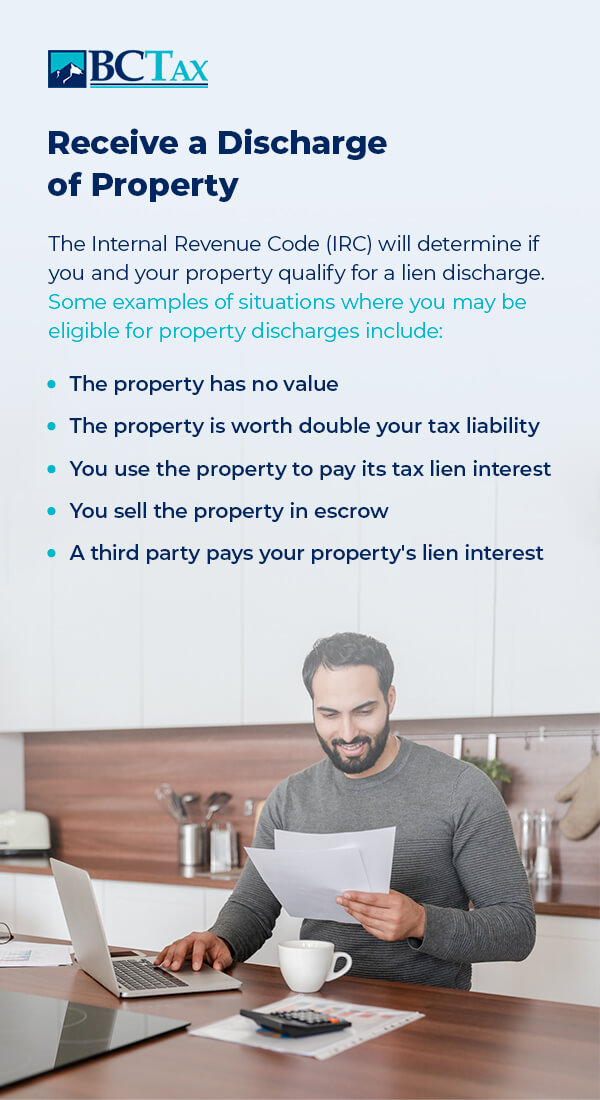
4. Apply for Subordination
When you’re considering how to get a tax lien removed, another option is to receive a Certificate of Subordination. You can think of subordination as the IRS letting another creditor cut in line. Subordination doesn’t get rid of the debt, so you can’t count on it for tax lien removal, but it does let another creditor move ahead of the IRS. If you’re looking to refinance your home or want to get a car loan, the IRS might agree to let the creditor’s claim take precedence over its own. Like a property discharge, the subordination will only apply to a specific asset or property.
When applying for subordination, you must meet the IRS’s qualifications. You can elect this tax lien removal strategy if you:
- Agree to pay your subordinating interest: Refinancing a mortgage or receiving additional funds through loans can provide the money you need to pay your debt. The IRS will approve a subordination if you can pay your property’s existing interest from your new loan.
- Refinance to increase your monthly payments to the IRS: Subordination opens your options to more creditors and opportunities, letting you find a loan with lower monthly payments. When you can pay less on your mortgage, you can allocate higher amounts to the IRS to pay off your debt.
A Certificate for Subordination can benefit many individuals struggling with a tax lien, allowing them to pay off their debt and remove the lien.
5. Get a Withdrawal
A withdrawal removes all public information about your tax lien. The IRS publicly posts all tax liens so that creditors know the government has a legal claim to the property. This notice makes it challenging to get new loans or sell your property. However, the IRS will withdraw the lien notice in some cases, even if you still owe money. The withdrawal doesn’t eliminate your debt but does allow you to apply for credit or sell your property without issue. Depending on your situation, the IRS may withdraw an NFTL according to provisions for:
- Inadvertent or premature notice filings
- Errors on the notice where the lien is applied to a limited liability company (LLC)
- Liens filed in designated disaster areas
- Installment agreement situations
- Circumstances where the withdrawal will make it easier for the IRS to collect the debt or you to pay it
- Situations where it’s in the best interests of all involved to remove the lien
- Special conditions
You can also qualify for a tax lien withdrawal in two main ways:
- Using a direct deposit installment method: Establishing a payment plan with regular installments can benefit taxpayers. A direct debit installment lets you qualify for a withdrawal when you’ve made three consecutive payments and have $25,000 or less left to pay.
- Complying with tax filings for three years after lien release: When the IRS releases your tax lien, the public records remain even after they update it to reflect your payment. A withdrawal can make it seem like you never had a tax lien, helping build trust with creditors. To qualify for this method, the IRS must have released your lien and you must have filed your taxes properly for at least three years.
A withdrawal can help individuals recovering from a tax lien and those opting for payment plans. Using a withdrawal will give you more access to other financial opportunities that can assist with payments and secure your assets.
Requesting a withdrawal requires you to fill out an application form and submit it to the IRS. BC Tax can help you determine whether sending in a withdrawal request is right for you. We can also work with you as you navigate the application process to give you the best chance of being granted your withdrawal.
6. Appeal the Lien
Sometimes, organizations file tax liens incorrectly or fail to follow the proper processes. In these cases, you can dispute and appeal the lien to remove it. You will need to appeal in a hearing to present your case and qualifications. Some grounds for appeal include the following:
- Full payment of taxes before the IRS filed the lien: You can qualify for an appeal if you paid your taxes but received a notice for a tax lien. The IRS should only file a tax lien when debt has accumulated after a failure to pay taxes.
- Errors with the IRS notification and filing process: The IRS must follow proper filing and notification processes and timelines when submitting tax liens. When you haven’t received the appropriate notice and time to complete payments, a tax lien can hurt your record and ability to earn credit. If the IRS fails to use the correct procedures, you can file for removal.
- Expired statute of limitations: The IRS has 10 years to collect tax debt and back taxes. While this statute of limitations has some exceptions, receiving a tax lien for taxes beyond the statute is grounds for an appeal and removal.
- Lien processed for the incorrect taxpayer: A filing and processing error might connect someone else’s debts to your name, causing you to receive a tax lien for debts that aren’t yours. An appeal and removal can rid the public records of the incorrect tax lien.
- No chance to dispute your amount owed: A failure to receive a notice of your right to a collection due process hearing can be an accidental denial of your rights. This hearing is essential for arguing that your stated debt is incorrect and providing a good case in your favor.
- Innocent spouse relief: You can qualify for a tax lien removal depending on who in your home files taxes. If your spouse is the only person responsible for filing and paying taxes, you can argue for innocent spouse relief, releasing you from the tax lien.
Keeping records of your past taxes is essential for repealing a tax lien. The IRS recommends storing tax records for at least three years after filing, but other situations might require you to fold onto them longer.
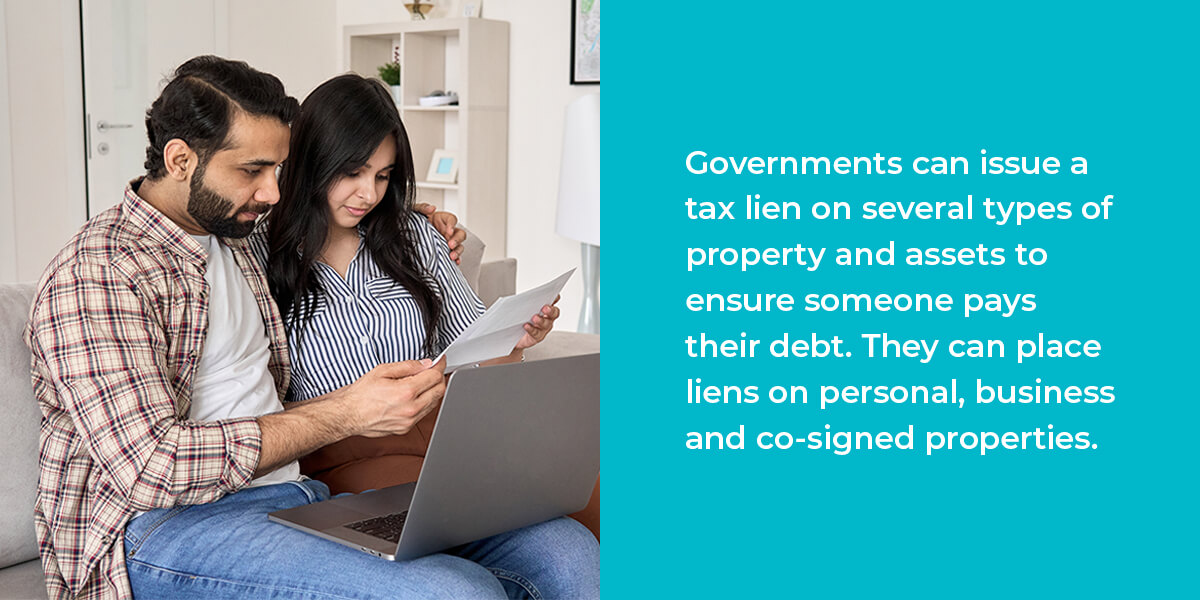
What Assets Can a Government Tax Lien Cover?
Governments can issue a tax lien on several types of property and assets to ensure someone pays their debt. They can place liens on personal, business and co-signed properties.
Some examples of what the government can lien include the following:
- Personal or commercial real estate
- Vehicles
- Wages
- Retirement payments
- Personal or business bank accounts
Since a lien applies to future properties as well as current ones, it can be challenging for individuals to invest in new assets or sell existing ones.
What Is a Levy?
While a lien acts as a security toward paying down your debt, a tax levy gives the government the right to repay it by seizing and selling your property. After failing to settle tax debts, the IRS will send a Final Notice of Intent to Levy and Notice of Your Right to a Hearing. This notice can help you prepare for the levy process, giving you time to dispute the lien or find an alternative payment method.
Liens vs. Levies
While liens and levies are related, understanding the difference between the two can help individuals prepare for both factors. A lien is a payment security that the government issues to ensure they receive the tax payments you owe. On the other hand, a levy is payment satisfaction — the government’s method to obtain a debt payment that went unsatisfied.
How to Avoid a Tax Lien
Figuring out how to remove a federal tax lien can be challenging, and it’s best to try to avoid one altogether.
The best way to prevent a tax lien is to file your taxes on time and in full each year. Working with tax consultants can help ensure you follow the right processes and reduce your filing risks.
Receive Help on Tax Lien Payments With BC Tax, LLC
At BC Tax, we understand how daunting tax debt is. Filing taxes is already complicated and challenging for many people and when small mistakes or missed payments lead to tax liens, we are here to help.
Partnering with the expert consultants at BC Tax can help you develop a tax lien plan based on your circumstances and situation. Consultants will work in your best interest to determine the best method to remove your tax lien. Contact BC Tax to learn more about how we can help remove your tax lien today!

 1-800-548-4639
1-800-548-4639